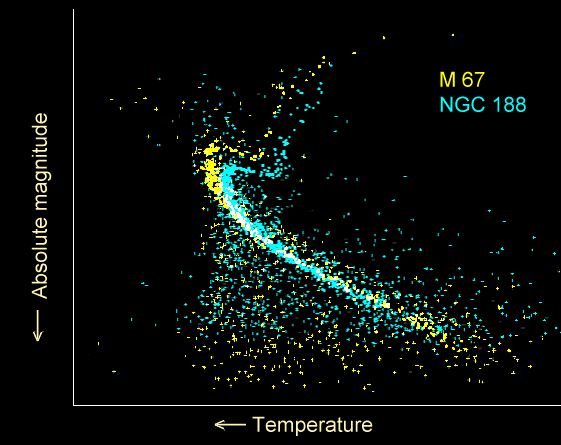Main-sequence Turnoff on:
[Wikipedia]
[Google]
[Amazon]
 The turnoff point for a
The turnoff point for a
 The turnoff point for a
The turnoff point for a star
A star is an astronomical object comprising a luminous spheroid of plasma (physics), plasma held together by its gravity. The List of nearest stars and brown dwarfs, nearest star to Earth is the Sun. Many other stars are visible to the naked ...
refers to the point on the Hertzsprung-Russell diagram where it leaves the main sequence
In astronomy, the main sequence is a continuous and distinctive band of stars that appears on plots of stellar color versus brightness. These color-magnitude plots are known as Hertzsprung–Russell diagrams after their co-developers, Ejnar Her ...
after its main fuel is exhaustedthe main sequence turnoff.
By plotting the turnoff points of individual stars in a star cluster
Star clusters are large groups of stars. Two main types of star clusters can be distinguished: globular clusters are tight groups of ten thousand to millions of old stars which are gravitationally bound, while open clusters are more loosely clust ...
one can estimate the cluster's age.
Stars with no turnoff point
Red dwarf
''Red Dwarf'' is a British science fiction comedy franchise created by Rob Grant and Doug Naylor, which primarily consists of a television sitcom that aired on BBC Two between 1988 and 1999, and on Dave since 2009, gaining a cult following. T ...
s, also referred to as classM stars, are stars of 0.08–0.40 solar masses. They have sufficient mass to sustain hydrogen-to- helium fusion via the proton–proton chain reaction, but they do not have sufficient mass to create the temperatures and pressures necessary to fuse helium into carbon, nitrogen or oxygen (see CNO cycle). However, all their hydrogen is available for fusion, and low temperature and pressure means a lifetime measured in trillions of years. For example, the lifespan of a star of 0.1 solar masses is six trillion years. This lifespan greatly exceeds the current age of the universe, therefore all red dwarfs are main sequence stars. Even though extremely long lived, those stars will eventually run out of fuel. Once all the available hydrogen has been fused stellar nucleosynthesis
Stellar nucleosynthesis is the creation (nucleosynthesis) of chemical elements by nuclear fusion reactions within stars. Stellar nucleosynthesis has occurred since the original creation of hydrogen, helium and lithium during the Big Bang. As a ...
stops, and the remaining helium slowly cools by radiation
In physics, radiation is the emission or transmission of energy in the form of waves or particles through space or through a material medium. This includes:
* ''electromagnetic radiation'', such as radio waves, microwaves, infrared, visi ...
. Gravity contracts the star until electron degeneracy pressure compensates and it goes off the main sequence, i.e. becomes a white dwarf.
References
{{Reflist Stellar evolution